The Intel Core i9-9990XE Review: All 14 Cores at 5.0 GHz
by Dr. Ian Cutress on October 28, 2019 10:00 AM ESTCPU Performance: Office Tests
The Office test suite is designed to focus around more industry standard tests that focus on office workflows, system meetings, some synthetics, but we also bundle compiler performance in with this section. For users that have to evaluate hardware in general, these are usually the benchmarks that most consider.
All of our benchmark results can also be found in our benchmark engine, Bench.
3DMark Physics: In-Game Physics Compute
Alongside PCMark is 3DMark, Futuremark’s (UL’s) gaming test suite. Each gaming tests consists of one or two GPU heavy scenes, along with a physics test that is indicative of when the test was written and the platform it is aimed at. The main overriding tests, in order of complexity, are Ice Storm, Cloud Gate, Sky Diver, Fire Strike, and Time Spy.
Some of the subtests offer variants, such as Ice Storm Unlimited, which is aimed at mobile platforms with an off-screen rendering, or Fire Strike Ultra which is aimed at high-end 4K systems with lots of the added features turned on. Time Spy also currently has an AVX-512 mode (which we may be using in the future).
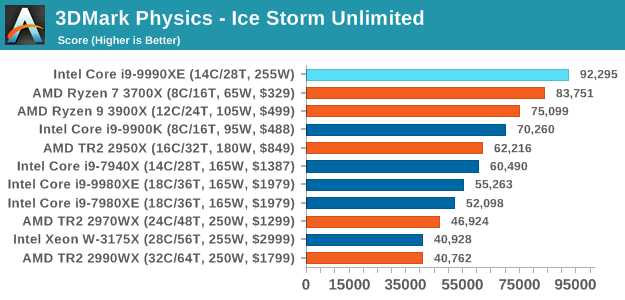
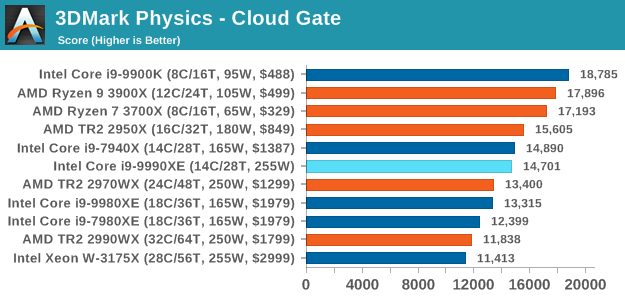
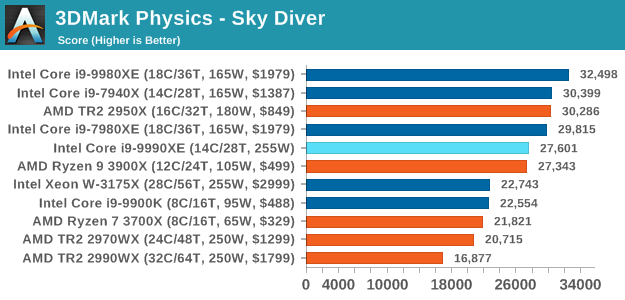
In simpler titles like Ice Storm, having that high frequency causes the 9990XE to be the best physics calculator for this test that we have.
GeekBench4: Synthetics
A common tool for cross-platform testing between mobile, PC, and Mac, GeekBench 4 is an ultimate exercise in synthetic testing across a range of algorithms looking for peak throughput. Tests include encryption, compression, fast Fourier transform, memory operations, n-body physics, matrix operations, histogram manipulation, and HTML parsing.
I’m including this test due to popular demand, although the results do come across as overly synthetic, and a lot of users often put a lot of weight behind the test due to the fact that it is compiled across different platforms (although with different compilers).
We record the main subtest scores (Crypto, Integer, Floating Point, Memory) in our benchmark database, but for the review we post the overall single and multi-threaded results.
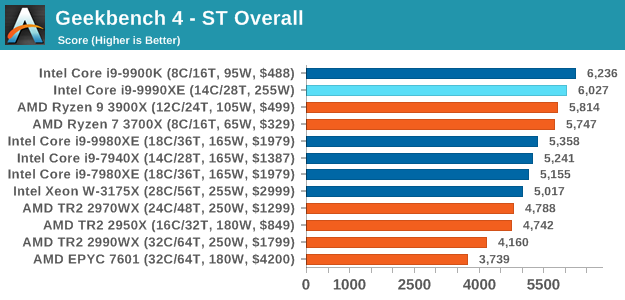
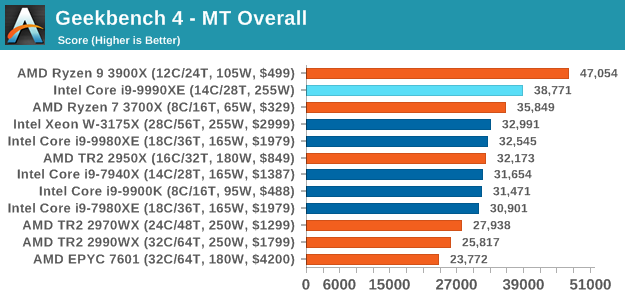










145 Comments
View All Comments
edzieba - Thursday, October 31, 2019 - link
An ASIC has a significant (many months to years) lead time between "we need X design" and functioning silicon. Trading algorithms are a constant arms race being updated to counter others' algorithm changes (who then counter your counters, etc) on the days to hours timescales.shtldr - Tuesday, October 29, 2019 - link
If you've got all the money (which you should, in case you are a successful algorithmic trader), why not go ASIC?Dribble - Monday, October 28, 2019 - link
It's not as simple as you need hundreds of threads or you need one. Compiling is an obvious example. You have a mixture of tasks - some take more threads (e.g. you have a large number of files in a makefile you can compile at once), some take less threads (you have a smaller makefile with only a few files), some take one thread (you need to link).A chip like this with 14 cores and very high single thread performance it turns out is ideal for this sort of task.
Compiling is very much not a niche market.
eek2121 - Monday, October 28, 2019 - link
Word (in the article) is that it helps with web browsing as well. So there is that. ;)That being said, I don't look at this CPU as being competitive to AMD offerings simply because you can't buy the thing. However it is nice to see that Intel can do something if they put their mind to it.
bananaforscale - Thursday, October 31, 2019 - link
Well, multiple cores *do* help with web browsing, doesn't mean you need 14@5 GHz. :DMattZN - Tuesday, October 29, 2019 - link
You don't need all those cores running on a single platform to do HFT. In fact, that winds up being a negative because all the cores are competing for memory cycles. Instead what you want to do is mirror (not split, but do a full mirror) the packet stream to a whole bunch of platforms with fewer cores which can then maximally leverage their memory bandwidth and CPU caches. You also filter the packets inside the NIC itself, not with the CPU.You also don't need to have a high-frequency CPU to minimize response time. The CPU is calculating outcomes from likely moves way ahead of time, long before actually receiving any packet telling it what movement actually happened. When the packet comes in, the CPU really only needs to look up the appropriate response from a table that has already been calculated. In fact, the NIC itself could do the table lookup for certain actions and bypass the CPU entirely.
So you want lots of cores, but they don't actually have to be ultra fast. Anyone using something like this processor to try to 'get ahead' in the HFT game is going to be in for a big surprise.
-Matt
Spunjji - Wednesday, October 30, 2019 - link
Thanks for the clarification. I thought that leaning on a single, many-core high-frequency CPU for this sort of task sounded a lot like optimising the wrong part of the whole process.peevee - Monday, October 28, 2019 - link
That's the point. It does not make them much money, the volume is simply not there. It is for INTEL's bragging.eek2121 - Monday, October 28, 2019 - link
They likely auction the chips due to the aggressive binning required. I expect if they could roll out this kind of chip easily, they would have already. Think: 10 chips for every 100,000 can do 4-5 GHz @ 14 cores, 255 watt TDP.lazarpandar - Monday, October 28, 2019 - link
So if you have an absurd amount of money and can't scale with more cores beyond 14...What a stupid product.